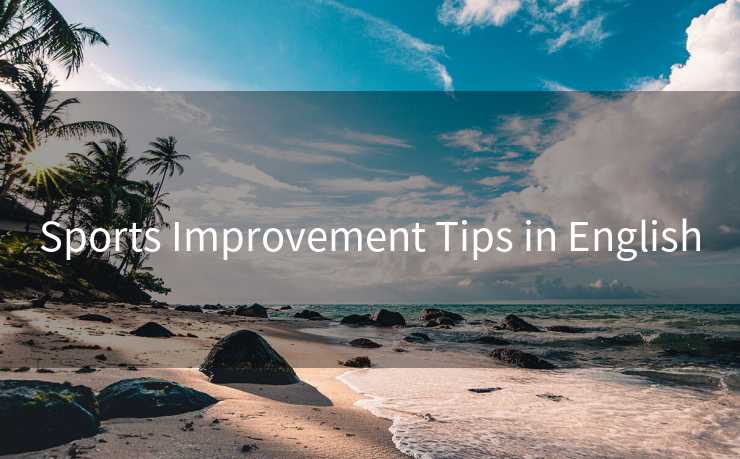Sports Improvement Tips in English
Whether you’re a professional athlete or a fitness enthusiast, enhancing your sports performance requires a strategic approach. With English being the global language of sports science, mastering key terminology and actionable advice can unlock new levels of progress. This guide breaks down essential tips—from training methods to nutrition—using clear, accessible English to help you elevate your game.

Why Focus on Sports Improvement?
Athletic growth isn’t just about working harder; it’s about working smarter. In today’s interconnected world, English resources—from research papers to coaching manuals—offer cutting-edge insights. By understanding terms like progressive overload (逐渐增加负重) or periodization (周期化训练), you gain access to proven strategies used by elite athletes. Whether your goal is running faster, lifting heavier, or dominating team sports, these tips will help you train efficiently and avoid common pitfalls.
Key Training Strategies for Better Results
Effective training balances intensity, frequency, and recovery. Here are foundational approaches to maximize gains:
Strength Training Fundamentals
Strength training builds muscle and power, but proper technique is non-negotiable. Start with compound movements like squats, deadlifts, and bench presses—they engage multiple muscle groups and boost overall strength. For beginners, aim for 3 sets of 8–12 reps per exercise, 2–3 times weekly. As you advance, use the progressive overload principle: gradually increase weight, reps, or sets to challenge your muscles. Remember, form over ego—poor technique leads to injuries that derail progress.
Aerobic and Anaerobic Conditioning
Aerobic exercise (e.g., running, cycling) improves endurance by strengthening your heart and lungs, while anaerobic workouts (e.g., sprints, HIIT) build speed and power. A balanced routine combines both: dedicate 3–4 days to aerobic training (20–40 minutes per session) and 2 days to anaerobic intervals (e.g., 30-second sprints followed by 90 seconds of rest). This mix enhances both stamina and explosive power, making you a more versatile athlete.
Nutrition Essentials for Athletes
What you eat fuels your body—and your performance. Optimize your diet with these guidelines:
Protein Intake and Muscle Recovery
Protein repairs muscle tissue after intense workouts. Aim for 1.6–2.2 grams of protein per kilogram of body weight daily. Good sources include lean meats (chicken, turkey), fish (salmon, tuna), eggs, dairy (Greek yogurt), and plant-based options (tofu, lentils). Post-workout, consume protein within 30–60 minutes to kickstart recovery—try a whey protein shake or grilled chicken with veggies.
Carbohydrates and Energy Levels
Carbs are your body’s primary energy source. Choose complex carbohydrates (oatmeal, brown rice, sweet potatoes) over simple sugars (candy, soda) for sustained energy. Before a workout, eat a small carb-rich snack (e.g., banana with peanut butter) to fuel your session. After training, replenish glycogen stores with carbs paired with protein—think rice and grilled salmon.
Hydration and Electrolyte Balance
Dehydration impairs performance and increases injury risk. Drink water consistently throughout the day, aiming for at least 8 glasses. During workouts, sip water every 15–20 minutes. For sessions longer than an hour (e.g., marathons, soccer games), add electrolytes (sodium, potassium) via sports drinks or coconut water to prevent cramps.
Mental Preparation and Goal Setting
Success in sports starts in the mind. Master these psychological tools to stay motivated:
SMART Goals for Long-Term Progress
Set Specific, Measurable, Achievable, Relevant, Time-bound goals. Instead of “get stronger,” try “increase my squat max from 100kg to 120kg in 6 months.” Break big goals into smaller milestones (e.g., adding 2.5kg to your squat each week) to track progress and stay accountable. Write down your goals and review them weekly—this reinforces commitment.
Stress Management Techniques
Competition pressure or heavy training loads can cause burnout. Practice stress-relief strategies like deep breathing (inhale for 4 counts, hold for 4, exhale for 6) or meditation (10 minutes daily). Visualize success—close your eyes and imagine nailing a lift or scoring a goal. These habits reduce anxiety and improve focus when it matters most.
Technical Skill Refinement
Mastering sport-specific skills separates good athletes from great ones. Focus on these areas:
Proper Form and Biomechanics
Incorrect form wastes energy and increases injury risk. For example, runners should land midfoot (not heel-first) to reduce knee strain, while weightlifters must keep their core tight during lifts. Use video analysis (record yourself performing exercises) or work with a coach to identify flaws. Small adjustments—like adjusting your grip width on a bench press—can lead to significant improvements.
Tactical Understanding in Team Sports
In team sports (soccer, basketball, volleyball), strategy is as important as physical ability. Study game footage to learn positioning and decision-making. For instance, a soccer player might analyze how top midfielders time their passes, while a basketball player could study pick-and-roll plays. Discuss tactics with teammates or coaches to deepen your understanding—knowledge gives you an edge on the field.
Recovery and Injury Prevention
Rest is not laziness—it’s part of training. Prioritize recovery to avoid burnout and setbacks:
Sleep Optimization for Athletes
Sleep is when your body repairs muscle and consolidates memory (including motor skills). Aim for 7–9 hours of quality sleep nightly. Create a bedtime routine (no screens 1 hour before bed, cool room temperature) to improve sleep quality. If you train hard, consider naps (20–30 minutes) during the day to boost recovery.
Active Recovery and Stretching Routines
Active recovery (low-intensity movement like walking, swimming, or yoga) boosts blood flow without straining muscles. Do this 1–2 days weekly instead of complete rest. Pair active recovery with stretching: hold static stretches (e.g., hamstring stretch, quad stretch) for 20–30 seconds per side. Avoid bouncing (ballistic stretching), which can cause injuries.
Conclusion: Integrating Tips Into Your Routine
Sports improvement is a journey, not a destination. Start by picking 1–2 tips from each section (e.g., add progressive overload to strength training and prioritize protein post-workout) and gradually incorporate more. Track your progress in a journal—note changes in strength, endurance, or mood to stay motivated. Remember, consistency beats perfection: small, sustainable changes yield lasting results.
By leveraging English-language resources and applying these evidence-based strategies, you’ll unlock your full athletic potential. Now lace up your shoes, grab your water bottle, and take the first step toward better performance!
(Image: A collage of athletes using the tips above—strength training, eating a balanced meal, meditating, and stretching—to emphasize holistic improvement.)

新闻资讯
站点信息
- 文章总数:1
- 页面总数:1
- 分类总数:1
- 标签总数:0
- 评论总数:0
- 浏览总数:0

